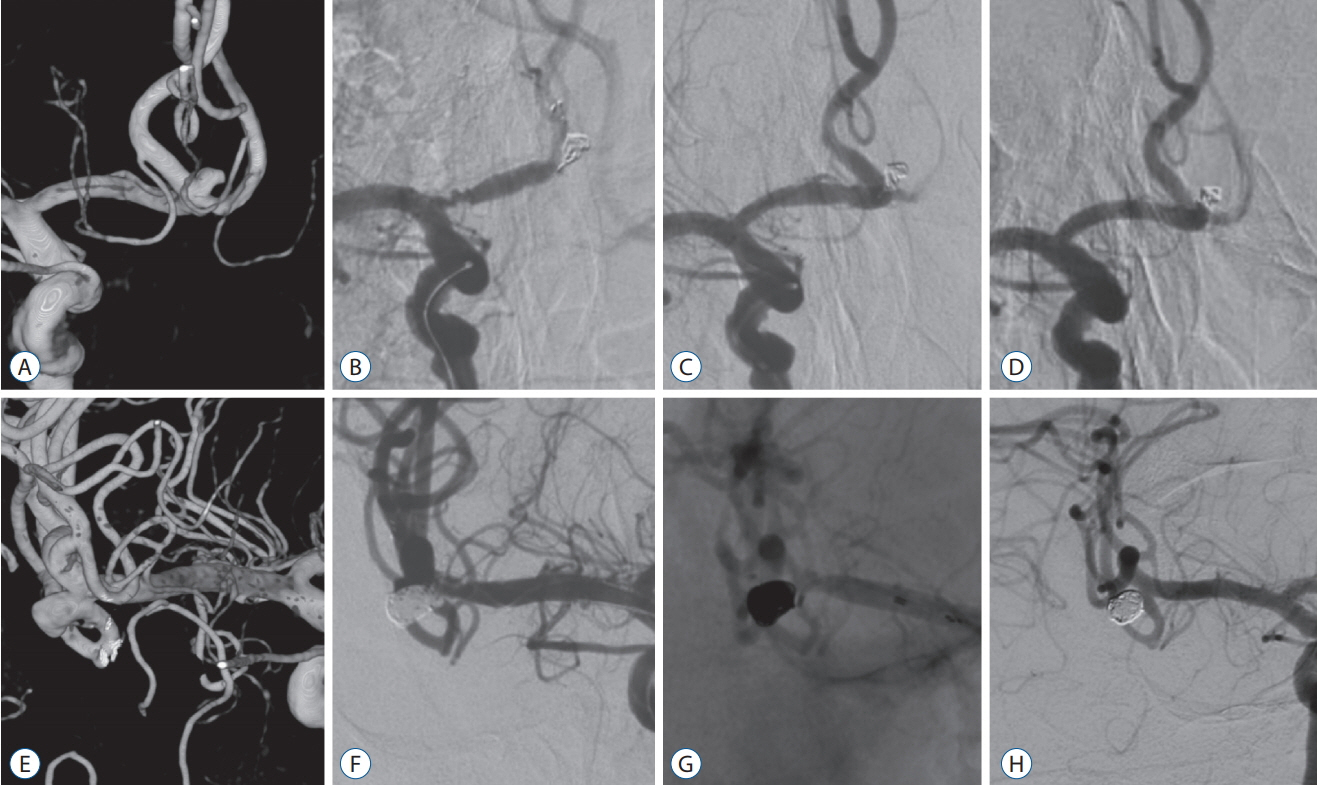J Korean Neurosurg Soc.
2019 Jan;62(1):27-34. 10.3340/jkns.2018.0064.
Selective Temporary Stent-Assisted Coil Embolization for Intracranial Wide-Necked Small Aneurysms Using Solitaire AB Retrievable Stent
- Affiliations
-
- 1Department of Neurosurgery, St. Paul's Hospital, College of Medicine, The Catholic University of Korea, Seoul, Korea.
- 2Department of Neurosurgery, Korea University Guro Hospital, Korea University College of Medicine, Seoul, Korea. nvkumc@gmail.com
- KMID: 2434343
- DOI: http://doi.org/10.3340/jkns.2018.0064
Abstract
OBJECTIVE
Stent-assisted coil embolization of intracranial wide-necked aneurysm requires long-term postoperative antiplatelet therapy to prevent in-stent thrombosis. This study aimed to demonstrate results of temporary stent placement for coiling wide necked small intracranial aneurysms, which eliminated need for antiplatelet agents, and to discuss its feasibility and safety.
METHODS
Data of 156 patients who underwent stent-assisted coil embolization between 2011 and 2014 were retrospectively analyzed. Thirteen cases of temporary stent-assisted coil embolization were included, and their clinical and radiological results were evaluated.
RESULTS
The aneurysms treated were all unruptured except one case. All of them had wide neck with mean dome-to-neck ratio of 0.96 and were small-sized aneurysms with mean maximal diameter of 4.2 mm. There was no technical failure in retrieval of stent after completion of embolization of the target aneurysm. Immediate angiography revealed 11 complete and two partial embolization (one residual neck and one residual aneurysm). Two cases encountered thrombosis complication, and they were managed without neurological sequelae. The mean follow-up period was 43 months, angiographic follow-up revealed two cases with minor recurrence, and clinical outcome was good with modified Rankin scale score of 0.
CONCLUSION
Temporary stent-assisted coil embolization of small wide-necked intracranial aneurysm using fully retrievable stent appears safe and effective. Further application and evaluation of this technique in more cases with larger size aneurysm is warranted.
Keyword
MeSH Terms
Figure
Reference
-
References
1. Almekhlafi MA, Hockley A, Wong JH, Goyal M. Temporary Solitaire stent neck remodeling in the coiling of ruptured aneurysms. J Neurointerv Surg. 5 Suppl 3:iii76–iii78. 2013.
Article2. Brinjikji W, Cloft HJ, Kallmes DF. Difficult aneurysms for endovascular treatment: overwide or undertall? AJNR Am J Neuroradiol. 30:1513–1517. 2009.
Article3. Chalouhi N, Jabbour P, Singhal S, Drueding R, Starke RM, Dalyai RT, et al. Stent-assisted coiling of intracranial aneurysms: predictors of complications, recanalization, and outcome in 508 cases. Stroke. 44:1348–1353. 2013.4. Chalouhi N, Jabbour P, Tjoumakaris S, Dumont AS, Chitale R, Rosenwasser RH, et al. Single-center experience with balloon-assisted coil embolization of intracranial aneurysms: safety, efficacy and indications. Clin Neurol Neurosurg. 115:607–613. 2013.
Article5. Choi HH, Lee JJ, Cho YD, Han MH, Cho WS, Kim JE, et al. Antiplatelet premedication for stent-assisted coil embolization of intracranial aneurysms: low-dose prasugrel vs clopidogrel. Neurosurgery. 83:981–988. 2018.
Article6. Fiorella D, Albuquerque FC, Masaryk TJ, Rasmussen PA, McDougall CG. Balloon-in-stent technique for the constructive endovascular treatment of “ultra-wide necked” circumferential aneurysms. Neurosurgery. 57:1218–1227. discussion 1218-1227. 2005.
Article7. Fischer S, Weber A, Carolus A, Drescher F, Götz F, Weber W. Coiling of wide-necked carotid artery aneurysms assisted by a temporary bridging device (Comaneci): preliminary experience. J Neurointerv Surg. 9:1039–1097. 2017.
Article8. Hetts SW, Turk A, English JD, Dowd CF, Mocco J, Prestigiacomo C, et al. Stent-assisted coiling versus coiling alone in unruptured intracranial aneurysms in the matrix and platinum science trial: safety, efficacy, and mid-term outcomes. AJNR Am J Neuroradiol. 35:698–705. 2014.
Article9. Huang QH, Wu YF, Xu Y, Hong B, Zhang L, Liu JM. Vascular geometry change because of endovascular stent placement for anterior communicating artery aneurysms. AJNR Am J Neuroradiol. 32:1721–1725. 2011.
Article10. Jeong HW, Seung WB. Outcomes of stent-assisted coil embolization of wide-necked intracranial aneurysms using the Solitaire™ AB neurovascular remodeling device. J Cerebrovasc Endovasc Neurosurg. 17:301–312. 2015.
Article11. Mascitelli JR, Moyle H, Oermann EK, Polykarpou MF, Patel AA, Doshi AH, et al. An update to the Raymond-Roy Occlusion Classification of intracranial aneurysms treated with coil embolization. J Neurointerv Surg. 7:496–502. 2015.
Article12. Mocco J, Snyder KV, Albuquerque FC, Bendok BR, Alan S B, Carpenter JS, et al. Treatment of intracranial aneurysms with the Enterprise stent: a multicenter registry. J Neurosurg. 110:35–39. 2009.
Article13. Molyneux AJ, Birks J, Clarke A, Sneade M, Kerr RS. The durability of endovascular coiling versus neurosurgical clipping of ruptured cerebral aneurysms: 18 year follow-up of the UK cohort of the International Subarachnoid Aneurysm Trial (ISAT). Lancet. 385:691–697. 2015.
Article14. Müller M, Brockmann C, Afat S, Nikoubashman O, Schubert GA, Reich A, et al. Temporary stent-assisted coil embolization as a treatment option for wide-neck aneurysms. AJNR Am J Neuroradiol. 38:1372–1376. 2017.
Article15. Ryu CW, Park S, Shin HS, Koh JS. Complications in stent-assisted endovascular therapy of ruptured intracranial aneurysms and relevance to antiplatelet administration: a systematic review. AJNR Am J Neuroradiol. 36:1682–1688. 2015.
Article16. Signorelli F, Gory B, Turjman F. Temporary solitaire stent-assisted coiling: a technique for the treatment of acutely ruptured wide-neck intracranial aneurysms. AJNR Am J Neuroradiol. 35:984–988. 2014.
Article17. Young JJ. Neointimal formation following drug-eluting stents: physiology, timeline, and the influence of drug delivery systems. Rev Cardiovasc Med 8 Suppl. 1:S3–S10. 2007.18. Zhu W, Tian Y, Zhou LF, Wang Y, Song D, Mao Y, et al. Development of a novel endothelial cell-seeded endovascular stent for intracranial aneurysm therapy. J Biomed Mater Res A. 85:715–721. 2008.
Article19. Zumofen DW, Sahasrabudhe N, Riina HA, Raz E, Shapiro M, Becske T, et al. Temporary stent scaffolding during aneurysm coiling. J Clin Neurosci. 21:852–854. 2014.
Article
- Full Text Links
- Actions
-
Cited
- CITED
-
- Close
- Share
- Similar articles
-
- Outcomes of Stent-assisted Coil Embolization of Wide-necked Intracranial Aneurysms Using the Solitaire(TM) AB Neurovascular Remodeling Device
- Clinical and Angiographic Outcomes of Wide-necked Aneurysms Treated with the Solitaire AB Stent
- Novel Noncrossing Y-Stent Technique Using Tapered Proximal End of a Solitaire AB Stent for Coil Embolization of Wide-Neck Bifurcation Aneurysms
- Solitaire AB Stent-Assisted Coiling of Wide-Neck Micro Aneurysms
- A Complicated Case of Endovascular Stent Assisted Coil Embolization of an Aneurysm




